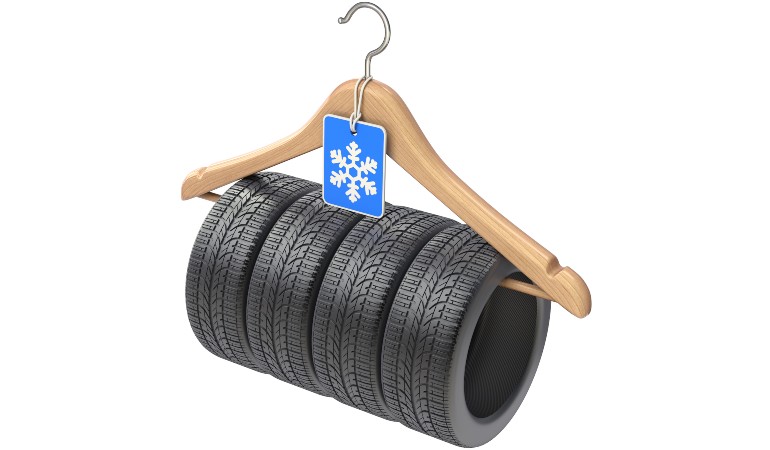
If you own a vehicle, then you know that ever so often, there comes a time to change your tyres. Normally, this happens due to weather reasons, such as switching from summer tyres to winter ones and vice versa. And here comes the question – how to store tyres?
Some people choose to store their tyres at home, while others need an alternative option, such as a professional storage facility. So, keep on reading if you want to find out how to store your tyres properly and ensure they stay in peak condition before using them again.
Table of Contents
How to prepare tyres for storage
When it comes to tyre storage, preparation is one of the most important things. Improper handling can lead to detrimental changes in the tyres’ characteristics, shortening their lifespan and resulting in premature replacement. Therefore, proper preparation is essential as it helps maintain the tyre’s integrity, ensuring years of reliable service and saving you money in the long run.
1. Clean the tyres
Getting your tyres ready for storage begins with their cleaning. Rubber could easily be damaged by chemicals like petrol, oil, etc. In addition, tyres get dirty from road grime and other debris. Therefore, you should pay special attention to this step of the tyre storage preparation.
You can use car cleaning detergent in combination with water and a tyre brush for optimal results. However, if you rinse them with a pressure-washing machine, be careful not to get too close and damage the rubber. Also, avoid using any dressing or gloss products.
There is certainly no need for that since car tyres are resistant and do not need any additional protection. Still, if you decide to apply such products, make sure to review the corresponding instructions for use.
Rims should also be prepared for storage. Use specialised detergent to clean the rims, and ensure all dirt and grime are removed. For optimal results, repeat the cleaning process if necessary.
2. Bag the tyres
Once you have ensured that your tyres are squeaky clean, you can proceed with the next step of the process – bagging the tyres. You should use airtight tyre storage bags, which could best protect them from the accumulation of grime and dust, as well as any damages.
You can find car tyre storage bags online or at a local automobile store. There are also tyre storage caddies and tyre totes. However, none of them is airtight, so you should use them only after putting the tyres in airtight bags.
Check also:
How to properly store your tyres
Different tyres require different conditions, which should not be overlooked if you want your car tyres to remain in good shape. Whether it’s protecting winter tyres from dryness or summer tyres from excessive heat, understanding these differences ensures optimal performance and extends their lifespan.
How to store winter tyres
Winter tyres could get damaged by direct sunlight and high temperatures. Therefore, the main thing when storing these tyres is to find a cool and shady place. The fact that you have already put them in plastic bags makes this even more possible, and those of you who have garages can use them as winter tyre storage. Avoid sheds or similar structures as they can become too hot.
Another option is to use the services of a nearby tyre hotel – specially designated places for winter tyre storage. However, if you store your winter car tyres without wheels, then leave them standing up vertically. If you store them with the wheels, then it would be better to leave them horizontally, one on top of the other.
How to store summer tyres
Storing summer tyres during the colder months is challenging, mainly because low temperatures can lead to various issues like deflation and cracking. Unlike winter tyres, which are designed for colder conditions, summer tyres are made from a softer rubber.
They have less elasticity and crack more easily if they get cold. Due to this, it’s better to store them inside. If you have an internal garage, that’s the perfect spot, as the warmth from your home acts as a safeguard against drastic temperature drops. In cases where an internal garage isn’t an option, consider a tyre hotel.
These facilities offer controlled environments specifically tailored for tyre storage, ensuring your tyres remain in prime condition until they’re needed again. By choosing indoor storage, you’re not just prolonging the lifespan of your summer tyres – you’re also safeguarding your investment and ensuring optimal performance when warmer weather returns.
How to store tyres with rims
If you have decided to store your tyres on rims, you should either hand them on a hook or store them horizontally, one on top of the other. However, if you store them vertically, which we recommend you avoid, you must switch the order every four weeks to prevent deformation of the bottom tyre.
How to store tyres without rims
If you store your tyres without rims, then you should put them horizontally. Don’t leave them in a vertical position; stack one on top of the other or hang them on hooks. Another important thing to remember is that you should rotate them every four weeks to a reasonably large degree.
What are the rules for storing tyres?
If you store your tyres incorrectly, you risk hindering their durability and overall performance. This ultimately means that their further usage can result in potentially dangerous situations. Therefore, you must avoid the incorrect ways of short-term tyre storage and long-term tyre storage and follow some essential rules to ensure they remain in top condition.
- Indoor Storage – keep your tyres indoors in a clean, dry, temperate, and well-ventilated area. Direct sunlight and exposure to the elements can degrade rubber over time.
- Avoid chemical exposure – store tyres away from any chemical substances, solvents, or hydrocarbons that could alter the rubber’s nature.
- Prevent penetration – keep them away from objects like metal tips or wood that could penetrate the rubber and cause punctures or damage.
- Heat and flame protection – protect tyres from heat sources, flames, incandescent materials, sparks, and ozone sources, such as electric motors, transformers, welding sets, etc.
- Prevent crushing – ensure that tyres are stored away from any objects that could crush them
- Outdoor storage precautions – if storing tyres outside (advisable only for a short period), raise them off the ground and use an impermeable covering with ventilation holes to prevent moisture buildup
- Clean surfaces – ensure the surfaces on which tyres are stored are clean and free from grease, petrol, solvents, oils, or other substances that could damage the rubber.
- Consider aesthetic factors – if your tyres have a white sidewall or raised white lettering, store them with these features facing each other to prevent potential staining from the black rubber.
- Relieve weight – if tyres are on a parked vehicle for an extended period, relieve them of its weight by either lifting the vehicle or removing them. Otherwise, irreversible damage could occur.
Your tires will be safely stored and preserved with us!
Enter your postcode to view our rates and availability in your area.
For questions about the services we offer visit our main site or you can always call us at 020 3746 0584
It’s crucial to optimise your tyre storage practices to maintain their quality and longevity. However, by following these guidelines, you’ll protect your tyres from premature wear and damage, ensuring optimal performance and safety on the road.














